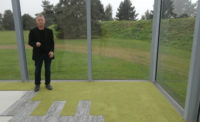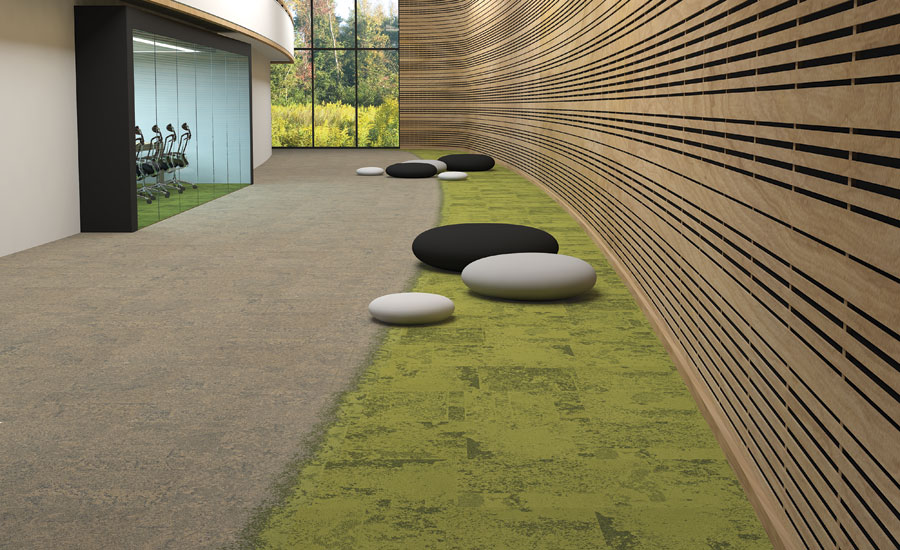Designer Q&A: Oakeys Discuss Latest Commercial Trends

Designer David Oakey and trend analyst Cindi Marshall Oakey strive to create a natural equilibrium between appearance, performance and sustainability, while always considering the full life cycle of the product being designed.

Studies show people are more relaxed and productive when surrounded by nature, so David and Cindi Oakey work to create products that help give the feeling of having the outdoors inside.


Before getting into things, just a quick background: David is the founder of David Oakey Designs and has been the exclusive product designer for Interface and its Flor division since 1994. When Interface founder Ray Anderson declared his company would be sustainable and closed loop by 2020, Oakey and his team quickly identified sustainable design must be innovative utilizing efficient use of materials, seeking smart products and eliminating waste during the process. As such, he leads global efforts in sustainable or “smart” design, learning from nature, the study of biomimicry.
As a trend analyst and futurist, Cindi not only keeps an eye on trends but how fashion, art, interior design and sustainability affects our culture. Through her global travels and research she correlates fashion and cultural trends with interior design.
FT: What overall design trends do you see for 2015?
David: The biggest shift is the blurring of design aesthetics between commercial or office, hotels in hospitality and residential segments instigated by the multi-use building boom.
FT: What colors are trending?
Cindi: We’re moving from the brightly colored playful spaces to more neutral based, mindful or quiet interiors. Bringing nature indoors is a blossoming trend, becoming more and more ubiquitous. As a result, we see an influx of warm grays, beiges and some dark wood. Shades of green often punctuate natural inspired interiors.
When color is used, they tend to be muted blue hues from teals, to true blue, navy and blue-toned purples.
FT: What’s influencing patterns?
David: Wood grain, and natural textures with deep weaves and fur create diversity and break up the monotony of neutral hues.
FT: Where have you seen these trends?
David: We’ve noticed bringing nature indoors has been a growing trend since late 2010 and 2011, worldwide. As populations, particularly millennials around the world gravitate to big cities the one thing lacking is nature. Nature makes us feel good. We’ve been working with biomimicry and biophilia since 2000 and now it’s really hitting mainstream popularity.
Cindi: The High Line Park in New York is the most popular and exceptionally well-executed example around the world. But we began seeing this trend in architecture in Milan, Italy, and even more widespread in Shanghai, Beijing and Singapore early on. Perhaps because Asia was in a high-rise building boom.
FT: What flooring businesses will be the first to embrace these trends?
David: There is no doubt that wood flooring and LVT (luxury vinyl tile) is leading the industry in every installation segment. There are some really high quality beautiful versions out there at a very good price. Ceramic tile made to look like wood grain or marble flooring is also popular. Of course, real hardwood floors are desirable when budgets allow.
FT: How do you think these trends will be reflected at NeoCon?
David: In the past few years, furniture manufacturers have been dealing with acoustics. As a result of the open plan office, noise and concentration have reduced productivity.
We’ve seen some comical attempts to create quiet spaces with felt cones and bowls surrounding a desk. The most popular are the glass meeting or conference capsules.
Take the hard surface flooring trend coupled with an open office plan and you have an even greater acoustical issue. What a perfect entre for carpet tile to create a barrier of sound absorption. Interface, for example, has a variety of skinny planks emulating the wood grain aesthetic that will compensate for noise level. And of course patterns like Walk the Plank, Near & Far, Equal Measure and Narratives will take the quiet aesthetic a step further with rich, dimensional textures all in subtle, neutral colors.
FT: What other industries (furnishings, wallcoverings, textiles, etc,) will showcase these trends at NeoCon?
David: The funny thing about office furniture, we still see a lot of brightly colored chairs—again around the world at shows in London, Cologne, and Melbourne, Australia.
Cindi: The big shift is that the flooring shown underneath is almost always neutral often accentuated by a complementing area rug. We expect the textile designs will embrace the bringing nature indoors concept through color, texture and fiber, and those really on their game will not make the designs quite so literal. That’s where there is opportunity for the quiet aesthetic.
FT: What lifestyle trends—art, fashion, movies, pop culture, etc.—are influencing products we’ll see at NeoCon?
David: Wellness. Some in the wellness field are concerned it’s becoming too generic of a term, somewhat like sustainability has: Each word can have a lot of different meanings to individuals. If you think about it, it makes sense the wellness trend is on the heels of the sustainability trend. In 1997, Interface’s Anderson declared his company goal would be closed loop manufacturing by 2020.
Cindi: We were both in Hawaii when he made the declaration. People thought he was crazy. It’s a long story but really, [Ray] changed the commercial interiors industry so that not only was everyone talking about sustainability, but scrambling to bring it into their products and practices. So we care about the environment and now, caring for our good health and longevity is at the forefront of individuals and businesses alike.
David: As a result, the hot new trend in office furniture is the flexible workstation. Experts prove that sitting in a chair 8 to 10 hours a day is bad for your back. Standing all those hours is taxing on your back and feet. Now flexible workstations rise to standing or lower to sitting as the individual chooses.
The next component in the design conversation needs to be what goes underfoot is carpet tile.
FT: What interiors industries provide cues to carpet design—fabrics, wallcoverings, counters, etc.?
Cindi: The wood flooring/hard surface boom is massive. In January at SURFACES in Las Vegas, perhaps 80% of the display floor was some type of hard surface. Of course they’re not talking about acoustics. Nonetheless, the hardwood and natural texture aesthetic is the biggest influence in flooring design today.
FT: Is social media, especially platforms like Pinterest and Houzz, creating a more discerning customer for both commercial and residential products? Are residential customers more aware of trends due to social media?
Cindi: Yes and no. Yes, there are savvy consumers with a flair for design who utilize Pinterest for all kinds of fun things from food to parties to fashion and to interior design. Houzz is a great tool to gather ideas if renovating is on the agenda.
And then there are those who still flip through magazines or simply go to a local store to see what to buy. There is a reason Home Depot is one of the largest residential [flooring] retailers.
Editor’s note: If you would like to know more about the latest design trends from the Oakeys, you can contact David Oakey Designs at (706) 882.6002 or info@davidoakeydesigns.com.
Looking for a reprint of this article?
From high-res PDFs to custom plaques, order your copy today!











